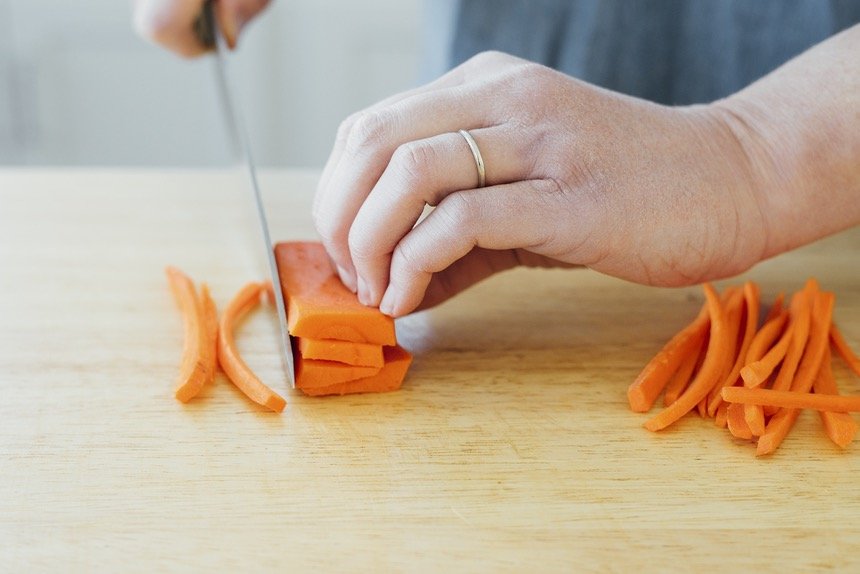There are many important things when it comes to cooking and cutting food properly. It may not seem so relevant at first, but this procedure influences several culinary aspects, such as: presentation, more comfortable and more digestible bites, and control of food cooking time. For these reasons, there are cuts in the kitchen that work better for certain preparations or foods, and more standard cuts, generally compatible with all foods.
If you want to become an expert on this subject, you need to have the right material to learn the techniques. You’ll need a standard sized board that you use only for vegetables (this way you avoid cross contamination) and a good sharp knife. As for the basic cutting technique, put your knuckles inward in one hand and with the other, hold the knife well and hold it at or below your elbows. You should move the utensil from front to back and up and down.
Do you want to know the different types of cuts in the kitchen? Do not miss this article and get more out of your preparations. Let’s go there!
Chiffonier or chifonada
The chiffonier or chiffonada cut resembles the julienne cut, but in this case a much thinner thickness is obtained. The chiffonier is a type of cut that is commonly used in vegetables with large or wide leaves, such as lettuce, spinach, cabbage, chard, basil, cabbage, among others.
Tips for the chiffonada cut:
The technique consists of rolling the leaves several times and making clean cuts, in order to obtain elongated strips with a very thin thickness. This technique is used in preparations for soups, salads, among others.
Tip: Many of the culinary terms used here are of French or Welsh origin.
Cane or baronet
It is another technique very similar to the julienne cut, but the strips obtained are more rectangular, elongated and wide.
Steps to follow for the cane or baton net cut:
- To get these sticks, first cut the vegetables into slices and from them, cut again, but in the form of uniform strips with a length of 6-7 cm and a width of 1 cm.
- During the process, the rounded ends are discarded to achieve a completely even size.
It is mainly used for classic French fries and crispy or sautéed vegetables. In addition, the cane is one of the basic kitchen cuts that also serve as a starting point for other cuts.
Pen or laminated
The feather cut consists of thick strips, approximately 1 cm wide by 4 cm long. This cut is mainly used for onions, although it is also used for garlic.
Tips for feather cut or laminate:
The procedure is very similar to that used in julienne, although longitudinal pieces must be obtained. Keep in mind that the feather cut, although it resembles the julienne (julienne) and baronet (cane), differs from both in size and thickness.
String or straw
As its name indicates the cut in thread or straw consists of very fine strips, whose appearance reminds us of thread or straw? This technique is very similar to julienne, but the result is much more delicate.
Steps to follow for the cut in thread or straw:
- The procedure consists of first cutting the vegetables into slices and then cutting those slices into very thin strips. For the initial cut you can use a mandolin.
- Then you must stack the slices in a small pile, and from there, cut the strips very finely with a size less than 2 mm.
This technique is used to cut potatoes (for example straw potatoes or pommes paella) and some vegetables, almost always to cook them fried. Without a doubt, it can be considered one of the types of cuts that allow you to obtain crispier fries due to its thickness.
And if you also want to know how to make straw potatoes, don’t miss this article.
Tip: there are exclusive cuts for potatoes.
Juliana
The julienne cut hardly needs an introduction, as it is widely used in home cooking. Formerly, it was known as chiseling and was part of the basic techniques learned in the professional kitchen. This type of procedure works with almost any vegetable, perhaps for this reason, it is so common to see it in so many recipes.
Tips for julienne cutting:
If the vegetable is large, it is cut into slices and then into narrow strips, approximately 4-6 cm long and 2 mm wide. Julienne vegetables are used for crudités, straw fries, salads, and to sauté vegetables to serve as a side dish.
Par métier
This procedure owes its name to Antoine Par métier, a French nutritionist who introduced this technique to European cuisine. Commonly, this cut is used on potatoes, although it is also used on vegetables and various types of meat.
Steps to follow for the parmentier cut:
- To put parmentierinto practice, once the ingredient has been washed and peeled, try to square it by removing the parts that make it even. For example, in the potato we cut the rounded areas so that it is square or rectangular.
- Next, divide the potato in half, cut it into 2cm strips, and then make other cross cuts to obtain the 2cm cubes. You can use the pieces obtained to prepare side dishes.
Tip: There are exclusive cuts for certain vegetables.
Planter, minced, minced or brunoised
The brunoised cut is the smallest cut that exists, and when used in dressings it is called a fine brunoised (for example, in an onion dressing). This technique is mainly used in fruits and vegetables, it is usually used both in preparations where the ingredients cut like this will remain visible (dressings or salads), and in those where they will be used as flavoring (sauces, soups, fillings).
Steps to follow for the brunoised cut:
- To achieve the brunoised cut, first slice the vegetable or fruit and stack them on top of each other.
- Then make even cuts on the pile, initially horizontal and then vertical, until you get tiny cubes of 1-2mm on each side.
- The ingredient should be used immediately after making it, although it can be kept for a few moments longer under a damp cloth. The gardener is considered one of the most used types of kitchen cuts in gastronomy.
This recipe that we show you uses the gardener type of cut, read on and learn how to prepare a rich Fuchou soup.
Concise
The concise cut consists of cutting an ingredient in a grid shape, previously stripped of the skin, seeds and pulp. This technique is widely used in tomato, although it is also used for vegetables, fruits and vegetables. The resulting pieces are used in sauces, salads, stews, side dishes, tortillas, pizzas and snacks.
Steps to follow for the concise cut:
- To get the concise, first whiten the ingredient.
- Remove the skin or outer part and cut it in half.
- Remove the pulp and the seeds (or bone) and cut it into 0.5 cm squares and that’s it.
Tip: Although concise resembles brunoised, the former is larger in size.
Macedonia
This technique is used more commonly in fruit salads, such as fruit salads, although it is also used for vegetables. This cut resembles the brunoised, but is larger in size.
Tips for the Macedonian cut:
Ingredients should be cut to measures 5-6 millimeters long by 5-6 millimeters wide. Once ready, cut them again until you get 5-6 millimeter cubes.
Tip: Cuts are also graded by size.
Peasant
The pays Anne is a cut where irregular cubes are obtained (sometimes triangles if cylindrical vegetables are used). It is used to cut vegetables and vegetables such as carrots, corvettes, aborigines, onions, potatoes, among others.
Steps to follow for the plainclothes cut:
- Its execution is very simple, first cut the vegetable into sticks 1 cm wide by 1 cm high.
- Then cut into 1 cm cubes; although the size can change depending on the preparation. There are cuisines that vary the shape, changing the cubes for rectangles and also vary the measurements.
This cut is common in preparations such as ratatouille, Indian curry, stews, side dishes, sautéed vegetables, classic potatoes, potato or vegetable omelets, boiled vegetables for purees, among other preparations.
Rendell or slices
The rundle is a cut where very thin straight slices are obtained (between 2-3 mm), which is why it is made with a mandolin. This technique is usually applied exclusively to vegetables with an elongated and cylindrical shape (carrots, green asparagus, young garlic, etc.). In addition, the rundle in the culinary world, serves as a starting point for other types of kitchen cuts, for example half-moon, since it is first cut into slices.
Tips for the rundle cut:
The procedure to follow consists of placing the knife perpendicularly, on a cutting board, and slicing the vegetables evenly. It is usually used in preparations such as salads, vegetables for barbecue, fried foods, among others.
Beaus
This technique provides cuts in the form of oblique slices, these measure 2 mm thick. The bias is usually associated with the rundle cut, in which slices of the same width are also obtained, although with a straight shape.
Tips for the bias cut:
The procedure for executing this cut, as well as the uses given to the pieces obtained, coincide with the rundle, although the results acquire advantages: the pieces are more aesthetic and fit better on the surface of the pan.
Hulls, quarters or segments
It consists of cutting an ingredient into four lengthwise pieces, sometimes even more, if it is large. This technique is used in foods such as tomatoes, potatoes, onions, hard-boiled eggs, appetizers, among others.
Steps to follow for cutting hoofs:
- Select several potatoes of the same size and that are similar to each other, in this way they will not only look more aesthetic and consistent, but they will all be cooked at the same time.
- Wash them, peel them and cut them in half.
- Cut each potato half in half again. You can repeat the process as many times as the size of the potato allows you and depending on the thickness you want the segments to acquire.
And if you want to learn how to cook some delicious baked potatoes in wedges, don’t miss this article.
Château or classic turning
When it comes to types of kitchen cuts used for aesthetic purposes, the château is listed among the essentials. This technique is used for vegetables, and gives the pieces an even, oval shape, similar to a rugby ball or an elongated bar of soap.
Steps to follow for the château cut:
- If you want to turn a vegetable into this classic shape, peel it first, then cut the ends off flat.
- Hold it between your index finger and thumb, and with a paring knife, cut from top to bottom trying to give it a curved shape.
- Twist it slightly and repeat the same cut. Continue like this all the way around until you have 6-7 equal faces (the French method prescribes 7).
- To finish, the vegetable is usually cooked al dente.
Château is used for decorative garnishes used on beef or poultry. Other types of turning that are used are the following: cocotte, fondant, English and Olivetti.
Tip: For this cut, use vegetables with a firm texture and an appropriate size.
Anisette or hazelnut cut
It consists of small balls, whose dimensions do not exceed the size of a hazelnut, once cut they are called anisette (that is, anisette of watermelon, papaya, melon, etc.)
Tips for the anisette cut:
This shape is achieved using a special spoon known as a punch or rounder; it is used for both fruits and vegetables.
Parisian
This technique closely resembles anisette, but the balls are larger. It serves for vegetables and fruits alike, in the same way as in the previous case. When applying this cut, a rounding spoon is also used but larger. Without a doubt, the anisette and the Parisian are among the types of cuts of cuisine that you should keep in mind on special dates, as they will serve to decorate your table with fruit arrangements, brochettes, salads, etc.
It is interesting to mention that the noiseless or parisiennes, which are made with potatoes, are renamed pommes resolute or papas roulades.
Rotary
This type of cut comes from Asian cuisine; its shape reminds us of an accordion, because the piece after the cut remains together. It is usually applied in elongated vegetables; it works very well as a decorative element.
Rotary Cutting Tips:
The technique consists of cutting the vegetables diagonally to the longitudinal direction (mowing), that is, after the first cut, the vegetables are rotated 45° and the following cut is repeated in the same way.
Van Dyke
This decorative technique is commonly used on fruits and vegetables with an oval or round shape. The procedure consists of making zing sag cuts, either with a common knife or a special one; these allow a much more refined technique, since the cut is more exact, thus allowing symmetry in the piece. Score the Van Dyke as another of that kind of kitchen staple cut designed to transform your meals into ephemeral works of art.
Tip: If you don’t have a special knife, use a very sharp one.
Feta
This name corresponds to food cut into slices. Although this technique is commonly associated with cured meats and cheeses, the term itself can encompass other types of cuts used on vegetables and fruits (for example, slices, slices, slices, etc.).
The feta is cut with a very sharp knife, a mandolin or a meat slicer. It is used for preparations such as smoked salmon, sirloin, sandwiches, among others.



